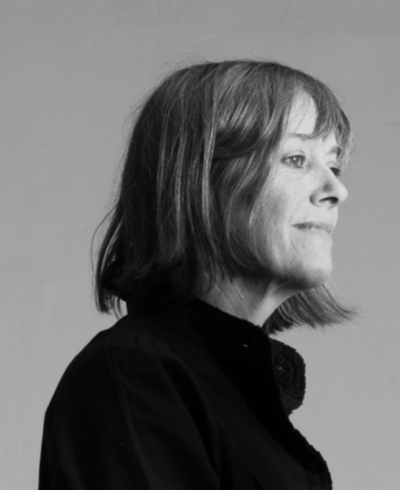Arrangement, Nathalie du Pasquier
from 9 March to 27 April 2024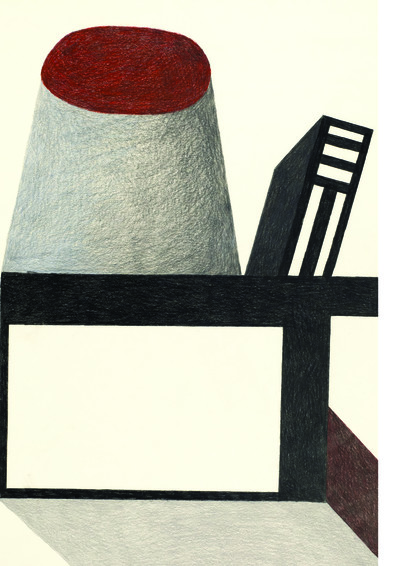
Dessin de Designer, Habiter avec la mer, Nathalie du Pasquier
After Pierre Charpin in 2022 and Ronan Bouroullec in 2023, Villa Noailles, as part of its off-site programming, showcases Nathalie Du Pasquier at the Hôtel des Arts in Toulon from March 8 to April 27, 2024. The exhibition will shed light on the drawings produced over the last thirty years by this artist, who has been living in Milan for over 40 years. After being a founding member of the Memphis group in the field of design and architecture in 1980, she has been primarily devoted to painting since 1987.
The exhibition will also be an opportunity to explore the documentary film “Portrait of my sister as an artist,” which Judith Du Pasquier dedicated to her sister in 2021.
Arrangements 1993-2023 is an exhibition focused on drawings and works on paper made by Nathalie Du Pasquier spanning three decades.
While for many artists drawing is primarily understood as a testing ground or blueprint for paintings, in NDP’s case the works on paper are works that stand alone.
NDP is averse to linear time and has again chosen to present the works without any chronological or thematic criteria. The show is conceived an archipelago of compositions obtained by juxtaposing drawings that, though born as only children, find themselves coexisting in extended families that enhance their meaning.
She pulled works on paper in different formats out of her drawers, some done in ink, others in colored pencil, and some others in brush, black or color. By synchronizing drawings of various techniques and times, NDP has created new polyphonic works that exist only for the duration of the show. This exhibition is thus a magical place for encounters to take place that could rarely happen elsewhere.
The works are presented without frames, as flat as the pages of the books with which the artist often enjoys experimenting.
Unlike painting, the drawings are made much more quickly, they are more casual and more adventurous. As opposed to those made when she worked with Memphis in the 1980s, these drawings are not project-based and they are
not meant to be applied to something. They are free spirits.
Besides images, the exhibition is filled with words borrowed from two French authors particularly dear to NDP: Pierre Mac Orlan and Chaval. Contrary to what we would expect, these text fragments are not intended to illustrate the images but operate on a parallel level, almost creating other images. Moreover, the texts are drawn and not printed, becoming a single visual stream.
Enjoy your viewing!
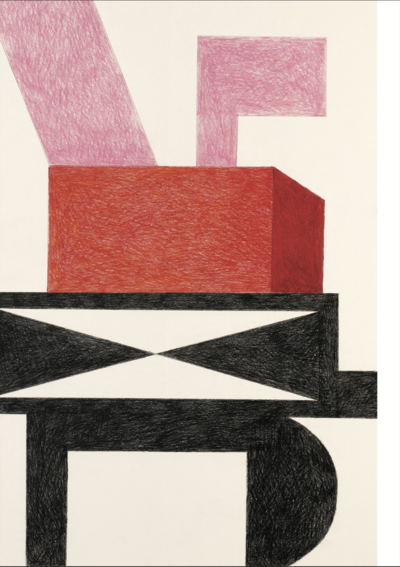
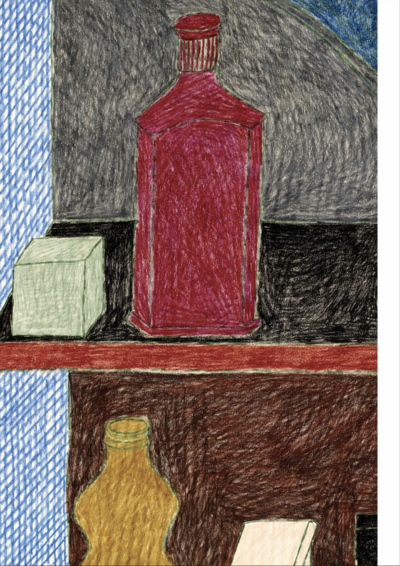
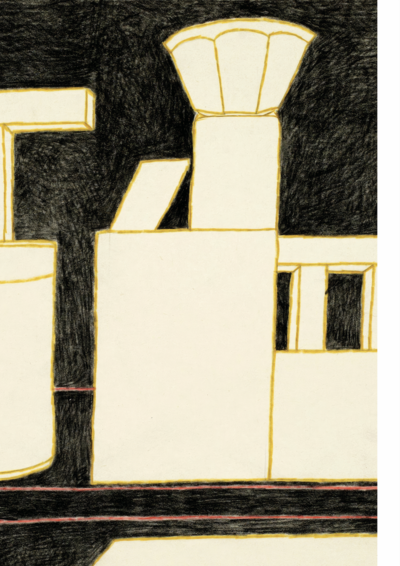
This exhibition is made up of very varied drawings taken out of disordered drawers, on the occasion of the Villa Noailles proposal. I am a painter and drawings occupy a different place in my practice. Long associated with project drawings from the 80s, it took me a while when I started painting to start making drawings again. Indeed, if there is no period during which I do not paint, there are sometimes long periods during which I do not draw.
My drawings are not preparatory sketches for paintings, they are works in their own right. What I have grouped under the term drawings for this exhibition are things on paper, in very different formats, in colored pencil, sometimes in ink, some with a brush, in black or in color. I kept the drawings/projects from the 80s away because when I started painting and abandoned my occupation around design, I entered a new territory. In this exhibition it is therefore the period which begins at the beginning of the 90s that I am interested in showing. This exhibition also gives me the opportunity, as I began to do with the
Campo di Marte exhibitions in Rome and Sérignan, to mix drawings from different techniques and periods to create new works. It is therefore a “contemporary art” exhibition!
There are drawings made during vacations when I can’t paint, which describe objects around me, there are drawings that tell stories, sometimes with characters, there are drawings of things that I would like to see, there are also, and these are more recent, abstract drawings which are a bit like paintings, still lifes/landscapes of shapes and colors. Each of these drawings is finished. As Georges Perec says, I am like the farmer who cultivates different things in his different fields. I like this country definition because it places these small works in a natural space without any particular ambition. Sometimes they give me ideas for paintings but it’s only when they’re finished that I eventually think about them. And then another advantage of working on paper is that I perhaps dare more, and I see the result more quickly.
So for this exhibition I composed arrangements of drawings from different periods on the walls and then I also installed some large drawings so that the eye does not stay scrutinizing the small drawings. I tried to compose rooms with some sort of themes that remain quite vague but I wanted to avoid monotony. When I started to take the drawings out of the drawers it seemed to me that I also wanted words or even sentences, to encourage the viewer not to fixate on the subject of the drawings but to construct a kind of narrative. That the kind of story that could have been told based on these arrangements was a story without head or tail perhaps, but a story where the words added other drawings to those on the wall. I have
always loved drawing letters and when I was young I think the first job I imagined I could do was “letter painter” as I had seen it done in Africa. So I started drawing words and sentences. As I am neither a writer nor a philosopher, I opened books that I like and which are currently on my table, and I randomly picked words from them. Some, banal, can be said by anyone, others are more identifiable, amateurs will perhaps recognize Chaval or Pierre Mac Orlan.
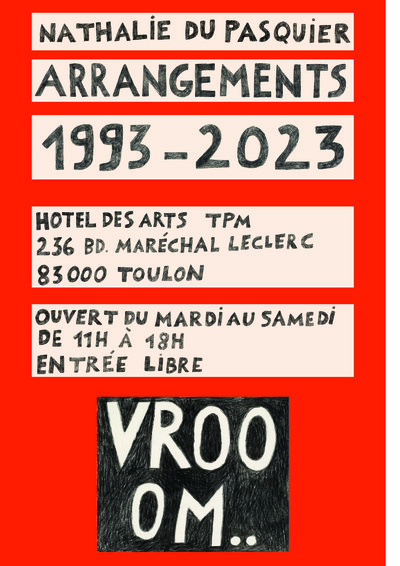
It is the first time you are presenting an exhibition focused on drawing or anyways works on paper. How did that come
about?
Actually, I was asked to do an exhibition only of drawing and I adapted to the request. I have a lot of things in my
drawers and I found works that I had forgotten about. Drawings are different from paintings, they are faster, you
are daring more.
Making a literary comparison, I would say that the painting would resemble a novel while the drawing is more like poetry. The drawing is a more direct and instinctive emanation of an idea while the painting corresponds to something more structured. However, there are artists who have handled drawing on a par with a painting and not in the manner of a sketch. I have the impression that this is also the case for you.
My drawings are not sketches or drafts for paintings but finished works. Unlike paintings, sketches are done much
more quickly and do not have to fit into a sequence of paintings, they are more casual. There are periods when I don’t draw, others when I draw a lot, and others when I make super precise drawings in pencil that look like paintings. But ink drawings are something else because it’s such a different medium. These drawings are the result of more intuitive gestures which in the end can be more mysterious. The mark which results from these movements is unexpected, it’s a more adventurous technique.
You said earlier that drawing is faster than painting. Do you mean this on a purely technical scale? Is the difference
only on that level or also on the conceptual dimension since some drawings are made as carefully as a painting?
The difference is in the technique. In works made with ink, the technique pushes you to do more immediate things. The way the brush gets on the paper with ink is very different from the way the pencil gets your hand to follow it on the paper.
I would add that we associate the pencil with something rewritable and erasable. Drawing gives you more freedom because it doesn’t require canvas, paints, brushes. It is cheaper.
Exactly. The economic aspect certainly also has something to do with the greater ease you have on paper.
In the exhibition you chose a specific time frame:1993/2023.
Why did you choose 1993?
In 1993 I felt safe enough to draw in a different way without the fear of continuing to touch the things I had wanted to leave behind.
In your history, drawing appears from the very beginning. During the time you worked with Memphis you were designing fabrics but also objets and architectures. You were confronting yourself with the same tool but in a totally different way.
Those were all projects even if they were not realised.
Many of the drawings from that time were functional but nonetheless out of your fantasies.
Totally. in fact when I published a book on my drawings from the 1980s I looked back at these forgotten drawings and realized that my new work had been influenced by things done in the past. I had for a long time divided the work into two definite phases to clarify how I wanted to present myself to the world. When I started painting I could not appear as a designer because at that time the separation between fields was still very clear and the versatility was not very well seen.
In recent years, starting first with books, you have increasingly begun to associate texts, excerpts from books or poems alongside your works. You tested this first on the two-dimensional space of the book and then translated it into the exhibition space. They are not simple quotations as you transcribe them in your own handwriting…The type of books you choose is also very consistent.
They are literary drawings.
This is the first exhibition where you put words next to the works.
Yes. I take great care to draw these texts and words myself because they become actual drawings.
Another uncommon aspect is your fascination with reproducing the works rather than the originals. You move from intervention on printed paper to three-dimensional space in a smooth way. Perhaps it is because of the old designer still in me working for something that wishes it could be reproduced. In my next exhibition I would like to bring only 1:1 scale
reproductions of works rather than the originals. I want to make a collage with the reproductions of paintings.
“I see the space and the walls as a page. This exhibition is very flat, it is designed like a book. Everything will be put up
without frames, just with nails and scotch tape.”
You don’t use any chronological order and in the exhibition you associate different elements (cut outs, pencil drawings,
ink drawings)..usually you work on exhibitions from mockups. In this case it was different
This time the model arrived only in a second phase. First I took the drawings and installed them on the wall as they
would be on the wall of the exhibition, then I took photos to see how they came out. I started by taking pictures of the works on a real wall and not on the model. model. I see the space and the walls as a page. This exhibition is very flat, it is designed like a book. Everything will be put up without frames, just with nails and scotch tape.
You never frame the drawings conferring to them a certain propensity to serve as elements to be integrated with
others within a large collage.
In the exhibition you dare more and the big collage you talk about can be modified during the installation, as if I
was working on a new drawing.
How did you choose the authors from whom you borrowed words for the exhibition?
Pierre Mac Orlan wrote songs that I really like. I had a book of his poetry where he wrote seemingly mundane things but all with a connection to the circus and a fauna of very free people. I liked having them as bystanders in the middle of the drawings.
The other words are by Chaval, a French humorist from my childhood, he still makes me laugh!
When you associate the word with the works inevitably the viewer is led to think they illustrate the images when in fact they operate on two complementary but separate levels.
I don’t want them to illustrate but to produce another image.
Although most of the drawings are abstract, geometric, in the exhibitions - thanks to the compositional approach in which you present them - they achieve a strong narrative dimension. I like how you treat the works in the exhibitions
because they are never isolated elements but part of blissful constellations.
The downplaying of art.
Nothing Definitely Perfect
“Nathalie brings them forward, transforming them into three-dimensional
structures that she then incorporates back into her
canvases. Her technique becomes a cycle of making, unmaking,
and remaking. Nothing remains definitively perfect!”
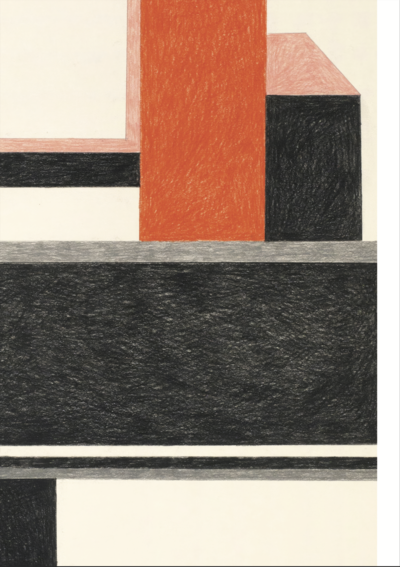
Since we forged the bonds of friendship in the mid- 1990s, a friendship of two individuals wholly committed to developing their artistic processes, each in their own way and for different purposes, I have never seen Nathalie pause or even take a break.
Natalie moves forward.
Amid all that unfolds, she remains acutely attuned and receptive to the world around her, be it near or far. Nothing can thwart the flow of her spirit or disrupt the intricate machinery within her— that relentless commitment to creation at a self-concocted cadence to punctuate the everyday. A rhythm harmonized with the strokes of painting, the lines of drawing, the structures of construction, and the grandeur of installations on a broader canvas (exhibitions).
During each visit, regrettably spaced too far apart due to our geographical separation, she opens the door to her studio with a welcoming smile, a large front wall emerging in the background illuminated from the side, her ongoing works hanging. I am always eager to gaze at what lies there, propelled by my curiosity and the desire for aggiornamento, to understand where Nathalie stands in her creative journey.
And consistently, whatever unfolds, regardless of its state, relegates what I had observed previously to the background. The unfolding moment, the ongoing act of creation, takes precedence over all else. This is the inner spring of Nathalie, her way of existing in the realm of painting and drawing, her way of existing in the world. All she has already achieved, which can only be considered substantial, and even what she might embark upon in the near or distant future, appears to have a relative importance, at least superficially. Such is her deep involvement and absorption in what captivates her in the present.
This becomes even more evident when Nathalie shares the series she is currently working on. With a tone imbued with the complicity that binds us— an intimacy born of each of us experiencing the drawing process firsthand —she tells me: “Pierre, you can’t imagine how delightful it is to create this series of drawings” (or paintings, constructions,
installations, etc.).
There’s no doubt whatsoever that this creative process is driven, perhaps above all else, by the joy and exhilaration of painting or drawing. However, it’s a nuanced and demanding pleasure that requires complete engagement and a certain rigor without diminishing the sensory dimension of her creations or how she brings her delineated forms—figurative or
abstract—alive on the canvas, paper sheet, or in space.
Even if what I see the moment I step into the studio has an undeniable connection to what I encountered during my previous visit, often months before, it is never exactly the same. Sometimes, it is not even remotely similar, yet it is still uncanny.
I must admit to a particular difficulty in recalling precisely what I had seen during the previous visit, the one before, or even earlier—I have 20 years of visits to look back on. I struggle to isolate and name a painting, a drawing, or a construction, even though I have frequently expressed my enthusiasm and particular interest in some of them—those that, more than others,
captivated my gaze. What my memory reflects is primarily a continuum in a slow evolution, where I can trace, in a
non-exhaustive or ‘scientific’ manner (leaving that task to more expert eyes), the various phases of the evolution of her artistic work.
Initially, Nathalie Du Pasquier, the designer and Memphis Group member, was known to me only by name. The Member Group was an association that significantly impacted her personal development through early immersion in the Milano-international socio-cultural milieu, often characterized by Ettore Sottsass’s influential and charismatic presence.
I encountered Nathalie, the artist, in person when her painting endeavors were already well underway, although not yet accorded the full recognition they rightfully receive today.
While my familiarity with her early ‘post-design’ works is somewhat constrained, I can nevertheless categorize this period as one marked by an exploratory nature, both in the technique of painting itself and in its content— questions of what to portray and how. Beyond this recurring intention (an unmistakable continuity with her work within the Memphis Group), the frequent presence of human figures strikes the eye. This motif would subsequently vanish entirely from the formal lexicon of
her paintings. This absence, perhaps, hints at an intention to position humanity not within the confines of the painting but squarely in front of it—either as its creator or observer. Alternatively, this recurring absence may suggest that humankind no longer finds its place amid the ever-expanding multitude of objects, of which it is the originator and producer.
In contrast, what I know most intimately by virtue of having access to her studio, the very site of the work’s progression, is her extended ‘style life’ period—which can be subdivided into distinct moments. Regardless, the act of painting is more assertive and deliberately controlled through gestures to create what I have previously coined as ‘circumscribed forms’: shapes meticulously defined by an acute focus on the precisions of their edges.
Simultaneously, the canvas increasingly transforms into a discernible space of reception, welcoming everything Nathalie introduces in varying degrees of order and density and primarily composed of commonplace objects amassed over the years in her studio. These objects are fundamentally regarded as form and color. In this progression, she gradually situates amid these objects (hitherto her subject or, at least, her pretext) simple geometric volumes that present themselves as
pure form, in stark contrast to the object-forms: a teapot, basket, stapler, ball of twine, hammer, dishcloth, carafe, brick, book, funnel, stones, and more.
What characterizes the major evolution of this ‘style life’ phase is the intensifying ebb and flow, a movement between what enters and what exits the canvas. This dynamic naturally leads to constructions and, subsequently, installations. After introducing objects and geometric volumes into the painting, Nathalie brings them forward, transforming them into three-dimensional structures that she then incorporates back into her canvases. Her technique becomes a cycle of making,
unmaking, and remaking. Nothing remains definitively perfect!
Everything is set into motion within a constantly reimagined arrangement, forming the basis of her plastic system. This system involves endlessly establishing new relationships and modes of articulation among the various elements at her disposal, including the fruits of her labor. No object stands in isolation; each object is destined to
enter a web of relations with others. The painting is no longer just an autonomous entity generating value within its own confines and frame, as it was in the past. Instead, it exists in relation to other objects and the space in which she places it. In this dynamic evolution, the presence of the commonplace objects from the early ‘style life’ period gradually diminishes or disappears (following the human figures and then the objects), making way for a language based on geometry. This is a warm geometry deliberately altered by the vibrancy of the brushstroke, the pencil, and the color.
Upon deeper reflection, I don’t believe it’s too speculative for me to trace the origins of all this to what Nathalie has long enjoyed doing—creating numerous small publications, notebooks, or books. Many of these are selfpublished, wherein she combines, arranges, intervenes, reframes, and composes with images from her own work and what she specifically produces for the publications. For instance, she adds words like “paf,” “crac,” “boum,” “biiip,” “wroom,” “domani,” “action,” “mistake”… words that are lively and resonant, much like the vivid and direct colors she employs in her books.
Considering these publications as secondary to her overall practice would be a lapse. Beyond their intrinsic qualities and the pleasure one experiences in viewing them, likely as strong as the pleasure she derives from conceiving them, it is through and within these publications that she has honed and established her art of arrangements. It took some time, a period of maturation, before she began to scale up and test in physical space— in her installations and exhibitions—what she joyfully and effortlessly experimented with in her publications.
Her exhibition “Big Objects Not Always Silent” at the Kunsthalle in Vienna in 2016 is the first large-scale demonstration of this, marking the inauguration of her practice of creating large installations. Since then, she has continued to realize such installations in various museums, art centers, and galleries across Europe and North America.
Everything I have endeavored to describe could not have taken shape in its immediately recognizable form as Nathalie’s without her profound interaction with the city of Milan, where she has lived and worked since the late 1970s. Milan is not the city of Bordeaux, her hometown, nor Paris, where she has never resided, nor Marseille or Rome, where she spent some time. Milan has its own light, distinct from both the South and the North, its colors, diverse architectural styles, facades with their
vocabularies, street widths, trams, cafes, sounds, scents, figures, personalities, and history. All of this is reflected in
what Milan produces aesthetically and culturally, and it is to this culture that Nathalie owes her belonging, perhaps
more so than to her roots.
Nathalie diligently progresses in the tranquility of her studio on Corso di Porta Nuova, with no road definitively laid out, not even the pursuit of creating a Work at any cost. Nathalie is right to feel detached from such a goal, as her work forms itself. It is the outcome of a lengthy process rather than an objective to be achieved.
She conceives and shapes the numerous exhibitions now dedicated to her in this space. These are not books held in hand and perused with the eyes but installations that occupy the entirety of the space. She invites us to enter with our entire being, to be seized and carried away by the allure emanating from her world of forms and colors—a realm she ceaselessly rearranges to enchant us anew with each encounter.
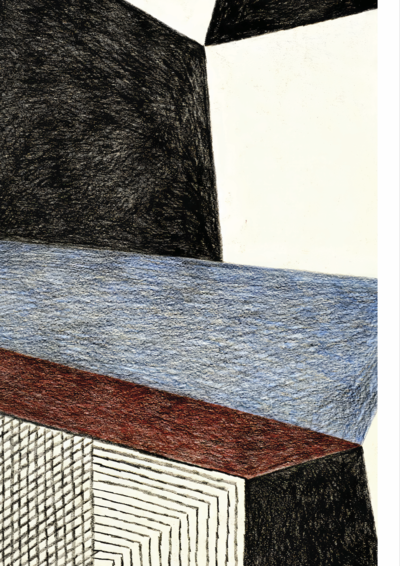
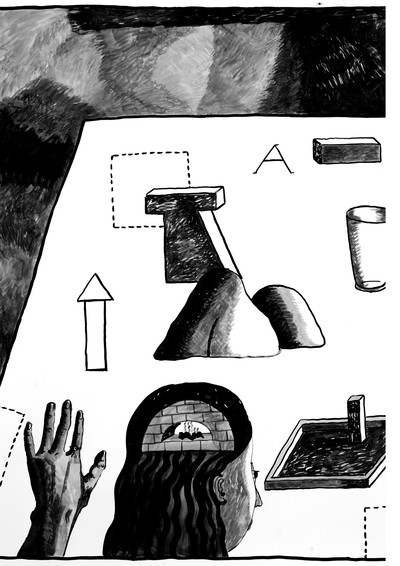
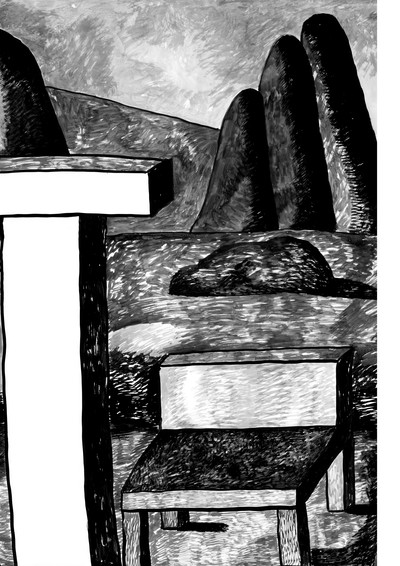
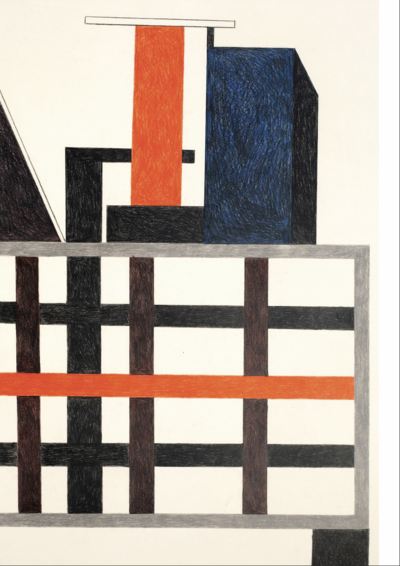
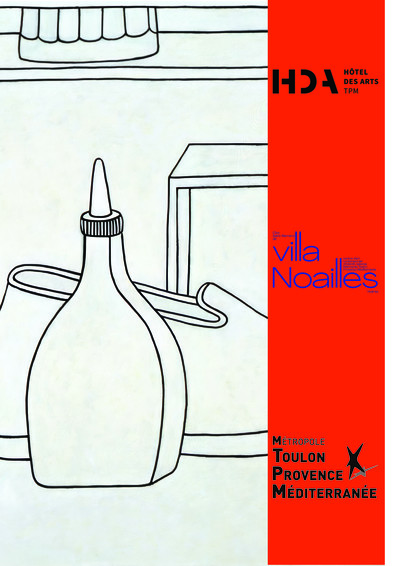
Nathalie Du Pasquier was born in Bordeaux in 1957, she has lived in Milan, Italy since 1979.
She worked as a designer, mainly of fabrics, and was part of the Memphis group, which led her to also design
furniture and objects. She worked with her partner George Sowden until 1987. She then began painting and
abandoned design.
For 20 years until 2009 she collaborated with a Hong Kong gallery, the Cadre Gallery, thanks to which her work progressed far from the constraints of the Western market. She also exhibited in a few galleries in Europe but it was only in 2016 during her first major exhibition in a museum, at the Kunsthalle in Vienna, invited by the Italian curator Luca Lo Pinto, that her work emerged.
When she began painting in 1987, the world of objects quickly became her main theme. It is a long series of still
lifes of objects in which her interest in the space between things and the structure of compositions developed. Little by little, she created wooden constructions from found pieces, which replaced the everyday objects she represented. These are colorful, abstract and quite geometric constructions. The resulting paintings appear to be abstract paintings although they are very realistic still biography lifes. Around 2014, she abandoned her models to develop constructions directly on the canvas. We can therefore say that it is from three-dimensional constructions that she approached abstraction. She continues to make these pieces in painted wood, sometimes large, which are now installed with the paintings. The work changes scale and it is the exhibition space which becomes the theme of the installation, like a large still life.
After the Kunsthalle in Vienna, she exhibited in 2017 at the ICA in Philadelphia and at the Camden Arts Center in
London, in 2021 and 2022 at the MACRO in Rome as well as at the MRAC in Sérignan, two exhibitions organized by Luca Lo Pinto, in 2022 she also had a show at the Villa Savoye in Poissy, in 2023 she exhibited at the Kunsthall
Aarhus in Denmark.
Her work is represented by different galleries: Apalazzo in Brescia, Pace in London, Yvon Lambert in Paris, Greta Meert in Brussels, Anton Kern in New York and recently Kerlin Gallery in Dublin.
In parallel with her main work as a painter, she also has some other collaborations, particularly with Mutina in the field of ceramics.
